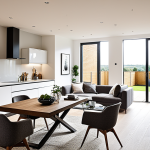Essential Elements of a Cat-Friendly UK Home
Creating a cat-friendly home UK demands attention to both the typical British living environment and feline needs. A comfortable environment for cats involves more than just providing food and shelter—it requires thoughtful design tailored to UK house types, which often include terraced houses, semi-detached homes, or flats with limited outdoor access.
To start, ensure ample indoor space with quiet, undisturbed zones for rest. Cats value secure, cosy spots, but also benefit from interactive spaces that allow exercise and mental stimulation indoors. For UK climates, which can be damp or chilly, warm bedding and draught-free zones are vital to protect cats from cold and humidity, which can affect their health.
Also read : Why Do Certain UK Pets Have Different Health Needs?
Safety is paramount. Given the UK’s traffic and urban density, secure indoor environments reduce risk, while enclosed outdoor gardens or cat-proof fencing help when allowing supervised outdoor access. Additionally, keeping potentially hazardous UK household items away from cats—like toxic plants and chemicals—is part of the UK cat care basics.
In summary, the essential elements of making a home cat-friendly in the UK focus on balancing cosy comfort, safety, and adapting spaces to the regional climate and home styles while promoting cats’ well-being and natural behaviours.
Also read : How Can UK Pet Owners Adapt Their Homes for Various Animal Types?
Designing Spaces for Cat Comfort and Enrichment
Creating a cat-friendly home UK means crafting a comfortable environment for cats that supports their natural behaviours through enrichment. Cozy spaces for cats are fundamental; plush bedding and snug hiding spots help cats relax and feel secure, soothing their instinctual need for safe retreats.
In a cat-friendly home UK, vertical spaces are just as crucial. Installing climbing towers, shelves, and scratching posts provides exercise and mental stimulation. Cats in UK homes often face limited outdoor access, so climbing structures compensate by encouraging natural agility and marking behaviours. This enriches the environment, preventing boredom which can lead to stress.
Outdoor access should be safe and adapted to UK living conditions. Many owners create cat-proofed enclosures or secure window perches that offer fresh air and visual interest without risks from traffic or predators. This careful balance promotes wellbeing while respecting UK cat care basics and safety concerns.
Additionally, rotating toys and interactive elements maintain engagement, supporting a stimulating environment for cats year-round. Indoor enrichment combined with cozy resting areas ensures a holistic approach — vital for cats living in various UK home types, whether flats or terraced houses. Well-designed spaces reduce stress and boost positive behaviour, making the home a true sanctuary.
Cat Essentials: Litter Boxes, Safe Plants, and Food Areas
Ensuring a comfortable environment for cats in a cat-friendly home UK starts with thoughtful placement and selection of cat essentials like litter boxes, plants, and feeding stations. A well-planned cat litter setup UK involves choosing trays that fit your available space while allowing easy access and privacy. For example, in typical UK homes where space may be limited, corner or covered litter trays can help maintain hygiene without compromising room flow. Regular cleaning is critical to prevent odours and ensure cats use the litter box consistently.
Selecting safe plants for cats contributes both to décor and wellbeing. Common toxic plants such as lilies and certain ferns found in UK homes should be avoided. Instead, cat-friendly species like spider plants, Boston ferns, or cat grass, which are widely available in UK nurseries, can be used to brighten spaces without endangering your pet. These help satisfy cats’ natural curiosity and chewing instincts safely indoors.
Organising a dedicated cat feeding area UK is essential, especially in multi-cat households. Feeding stations should be in low-traffic, quiet spots, separated from litter boxes, to reduce stress and encourage healthy eating habits. Providing fresh water nearby and maintaining clean bowls supports overall cat health and comfort, fulfilling core UK cat care basics for a harmonious home environment.
UK-Specific Cat Care Considerations
Balancing a cat-friendly home UK with regional realities means understanding UK cat care basics alongside climate and legal factors. One key aspect involves addressing the UK’s often cold and damp environment. Cats require cosy, draught-free resting areas to maintain body warmth, especially during chilly months. Using insulated bedding and placing sleeping spots away from windows or doors reduces exposure to cold and moisture, helping preserve health in a typical UK home.
In terms of housing layouts, many UK cats live in flats or terraced houses where outdoor access is limited. Creating safe, sturdy indoor climbing structures or window perches allows cats to satisfy curiosity and exercise needs without exposure to external dangers. These adaptations align with a comfortable environment for cats while respecting limited space available in many UK homes.
Navigating UK pet laws is crucial for responsible ownership. While cats generally have fewer restrictions than other pets, owners must ensure outdoor access does not cause nuisance or harm local wildlife. Microchipping is mandatory, enhancing safety and identification.
By integrating these considerations—climate-appropriate comfort, housing adaptations, and legal compliance—owners create a cat-friendly home UK that supports feline welfare realistically and thoroughly.
Essential Elements of a Cat-Friendly UK Home
Creating a cat-friendly home UK means prioritising a comfortable environment for cats while adapting to typical British house types and climate realities. Since many UK homes are terraced, semi-detached, or flats, space is often limited, making it crucial to optimise indoor areas for privacy and activity. Cats need quiet, secluded zones for rest, away from household noise and traffic, contributing to their overall wellbeing.
Adapting to the UK’s often chilly and damp climate also involves providing draught-free, warm hiding places with insulated bedding to maintain feline health. A comfortable environment for cats requires combating humidity, common in UK homes, which can stress cats if they cannot find cosy retreats.
Safety and security are integral to UK cat care basics. Indoor environments should be secured to prevent escape, especially in urban settings with traffic and predators. When allowing outdoor access, cat-proof fencing or enclosed gardens ensure cats explore safely without risk to themselves or local wildlife. Hazardous substances and toxic plants prevalent in UK households must be stored securely to protect cats.
Balancing warmth, space optimisation, and safety addresses the main requirements of a cat-friendly home UK, helping cats thrive indoors while accommodating the unique challenges posed by British homes and climate.






